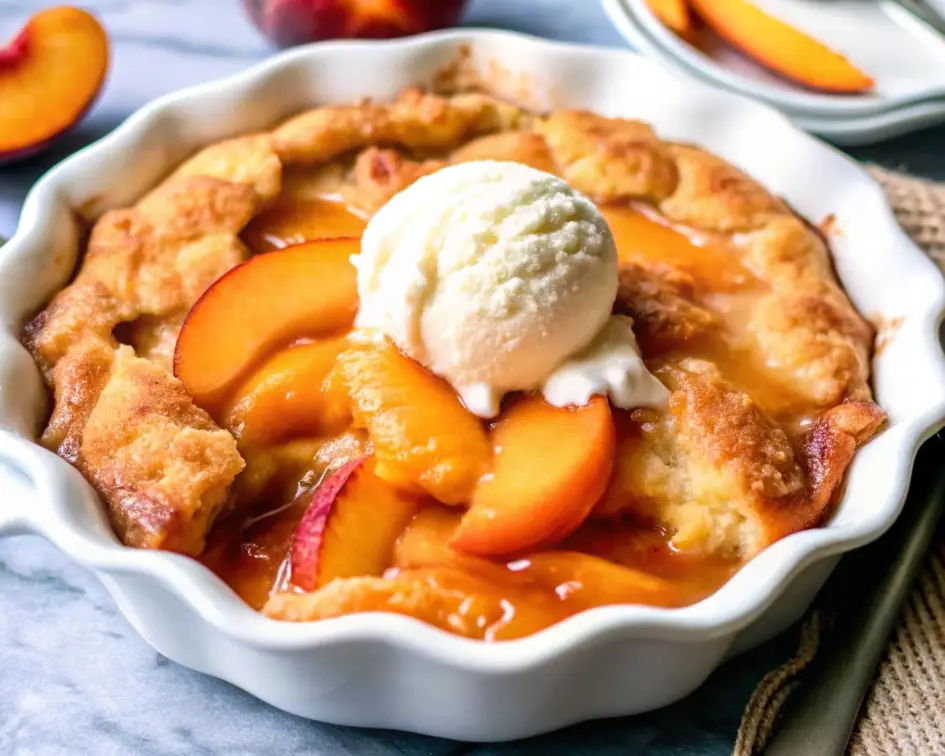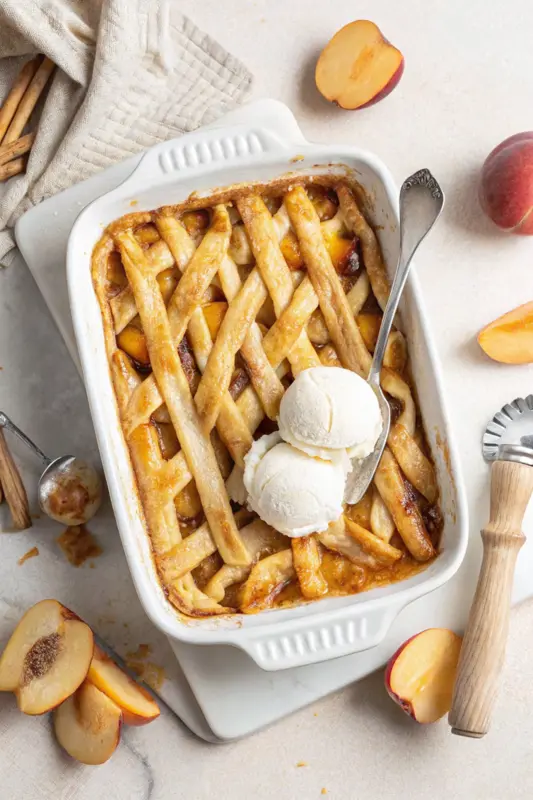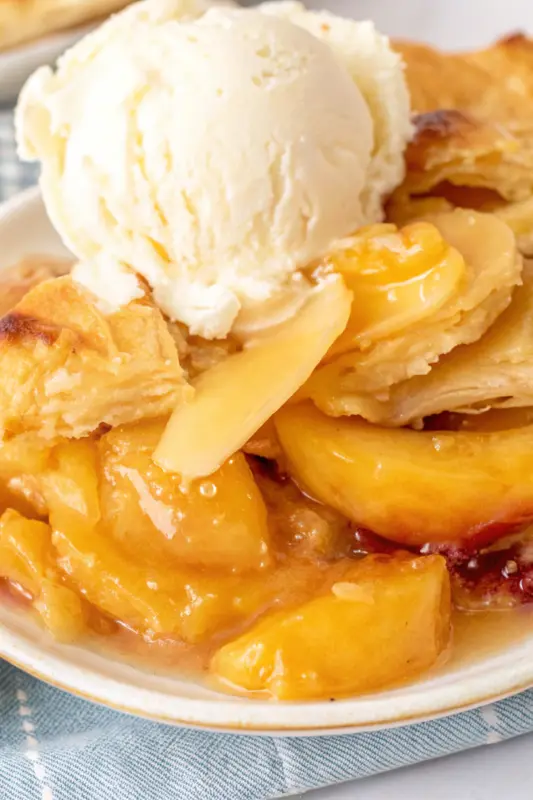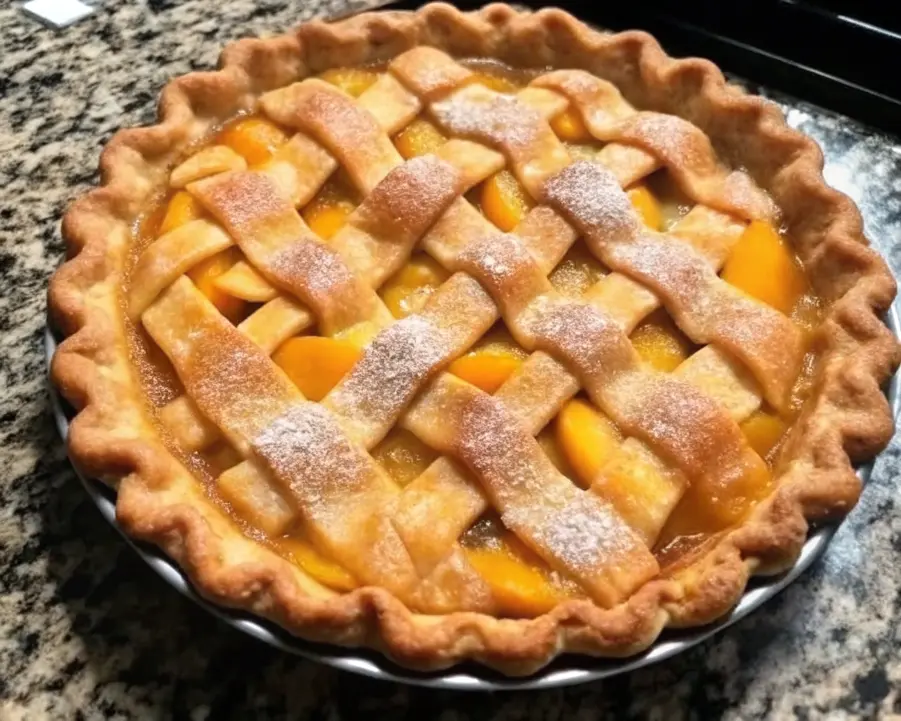Introduction to Peach Cobbler Pie
Peach cobbler pie is a true Southern classic that blends the best of both worlds—a delicious fruit cobbler and a comforting pie. With a flaky, buttery crust and a sweet peach filling, this dessert is a celebration of summer flavors and nostalgia. From family gatherings to weekend picnics, peach cobbler pie brings warmth and smiles to every table.
While cobblers and pies are quite similar, peach cobbler pie has a distinctive lattice crust that sets it apart from a traditional cobbler. Learn how to make this delightful dessert and impress your guests with a perfect slice of Southern charm. For a better understanding of what makes this dish unique, you might find.
What is Peach Cobbler Pie?
Peach cobbler pie combines the soft, juicy texture of peaches with the crispy crunch of a lattice pie crust. It’s less structured than a standard pie, and the texture of the filling is designed to be rustic and comforting. Unlike traditional peach pies, peach cobbler pies often use a mix of fresh, canned, or frozen peaches, allowing flexibility depending on the season or availability.
For those new to cobbler-style desserts, it’s important to understand how the ingredients and process contribute to the dessert’s signature cobbled look. If you need help mastering the lattice crust, this guide to perfect pie crust techniques is a valuable resource.

Ingredients and Their Roles
Fresh vs. Frozen vs. Canned Peaches
- Fresh peaches: Ideal for summer, especially when they’re in season. Fresh peaches have a wonderful texture and vibrant flavor.
- Frozen peaches: These are a great substitute when peaches aren’t in season. Frozen peaches are often packed at peak ripeness, making them a reliable option.
- Canned peaches: An easy and convenient option, though it’s important to choose peaches in light syrup rather than heavy syrup to control sweetness.
Sweeteners and Spices
- Granulated sugar and brown sugar: Provide the perfect balance of sweetness. Brown sugar adds a hint of caramel flavor.
- Ground cinnamon and nutmeg: Essential spices that give the cobbler a warm, cozy flavor.
Thickening Agents
- Cornstarch or flour: These help thicken the peach filling, ensuring it’s not too runny.
Pie Crust Types
You can use either a store-bought pie crust or make your own at home. Homemade crust provides that extra layer of flaky, buttery goodness.
How to Make Peach Cobbler Pie
Preparing the Filling
- In a large bowl, combine peaches, sugar, cinnamon, nutmeg, and lemon juice.
- If using frozen peaches, there’s no need to thaw them first—they will bake perfectly from frozen.
- Let the mixture sit for 10 minutes, allowing the juices to blend with the sugar.
Making and Assembling the Crust
- Roll out the pie crust on a floured surface.
- Cut dough into 10-12 strips for a lattice top. Lay 5-6 strips vertically on the peach mixture.
- Fold back every other strip halfway and lay another strip horizontally to create a woven pattern. Repeat until complete.
Baking Tips
- Preheat the oven to 400°F. Bake the cobbler for 15 minutes at this temperature before reducing it to 350°F for another 40-50 minutes.
- To prevent over-browning, cover the crust with foil towards the end if necessary.
Tips for the Perfect Peach Cobbler Pie
Choosing the Right Peaches
- Look for ripe, firm peaches with a slight give when squeezed. The quality of your peaches makes all the difference in flavor.
Avoiding a Soggy Bottom
- Avoid excess moisture by using a slotted spoon to transfer peaches to the pie crust, leaving excess juice behind.
Ensuring a Crisp Top Crust
- Brushing the top crust with egg wash and sprinkling it with sugar ensures a golden-brown, crispy finish.
Serving Suggestions
With Ice Cream or Whipped Cream
- Serve warm with a generous scoop of vanilla ice cream or a dollop of whipped cream. The creamy texture pairs perfectly with the spiced peach filling.
Alternative Toppings
- Caramel drizzle or toasted almond flakes add an extra layer of flavor.
Serving Temperature
- The cobbler is best served warm but can also be enjoyed at room temperature. Allow it to cool for about 20 minutes to let the juices thicken.
Part 2: Peach Cobbler Pie: Tips, Variations, and FAQs
Variations of Peach Cobbler Pie
Adding Berries or Other Fruits
- Add blueberries or raspberries to the peach mixture to create a mixed-fruit cobbler. The tartness of the berries complements the sweetness of the peaches.
Crumb Topping vs. Lattice Crust
- A crumb topping can be used instead of a lattice crust for a different texture. Combine flour, sugar, butter, and oats for a crunchy topping.
Gluten-Free and Vegan Options
- For a gluten-free version, use gluten-free flour and a gluten-free crust. Substitute butter with vegan margarine for a vegan-friendly version.
Common Mistakes and How to Avoid Them
Too Watery Filling
- If the filling is too runny, add more cornstarch or flour to absorb the excess liquid.
Undercooked Crust
- Make sure to preheat the oven properly and bake long enough for the crust to cook through.
Burnt Top Crust
- Cover the top loosely with foil during the last 10-15 minutes of baking to prevent burning.
Storage and Reheating Instructions
Storing in the Refrigerator
- Cover the cobbler and store it in the fridge for up to four days.
Freezing Tips
- The cobbler can be frozen after baking. Allow it to cool completely before wrapping tightly and freezing. Thaw in the fridge before reheating.
Reheating Methods
- Reheat in the oven at 350°F until warmed through or use the microwave for a quicker option.

Frequently Asked Questions
Why Do You Need to Layer the Butter, Batter, and Peaches This Way?
- Layering the butter, batter, and peaches creates a characteristic cobbled look. The layers rise and bake together to form a delicious texture.
Can You Use Frozen Peaches?
- Yes, frozen peaches work great. Just let them defrost in the bowl with the sugar as instructed.
Can I Make Peach Cobbler Pie Ahead of Time?
- The cobbler can be made ahead, but it’s best fresh. Reheating works, but the crust may lose some crispness.
Is It Okay to Dice the Peaches Instead of Slicing Them?
- Yes, diced peaches work fine and may make it easier to scoop and serve.
Peach Cobbler Pie Recipe Summary
- This peach cobbler pie is easy to make, versatile, and always a crowd-pleaser. The combination of fresh peaches, warm spices, and a flaky crust makes it the perfect summer dessert.
Conclusion and Final Tips
- Whether you choose to add berries, change the topping, or adapt the recipe to dietary needs, peach cobbler pie remains a comforting and delicious dessert for all occasions. Make sure to serve it warm for the best experience.
Additional Resources and Recommended Recipes
- For more delicious peach desserts, try peach pound cake or grilled peaches with caramel sauce to keep the summer flavors going!
Part 3: Expanding Peach Cobbler Pie: Advanced Techniques, Nutrition, and History
Advanced Techniques for Peach Cobbler Pie
Making a Homemade Pie Crust from Scratch
- A homemade pie crust elevates your cobbler pie to a new level. Use all-purpose flour, cold butter, and ice water for a flaky and tender crust. The key is to work quickly to keep the butter cold, ensuring the crust remains flaky.
- Roll out the dough evenly, ensuring it’s not too thick or too thin. An even thickness helps the crust bake uniformly.
Perfecting the Lattice Top
- Creating a beautiful lattice top can make your cobbler pie look professional. Roll out the dough into strips, and create a woven pattern by folding back alternating strips and placing others in the opposite direction.
- For an extra golden crust, brush with an egg wash and sprinkle with turbinado sugar before baking.
Adding Flavor Enhancers
- Add a tablespoon of peach schnapps or vanilla extract to the filling for enhanced flavor. This small addition can bring out the peach flavor even more.
- Use a cinnamon stick in the filling mixture for a more complex spice profile. Remove the stick before assembling the pie.
Nutritional Information and Health Benefits
Calories and Macros
- A typical serving of peach cobbler pie contains approximately 280 calories, with carbohydrates being the main macronutrient due to the sugar and crust.
- Fat content comes from butter in both the crust and filling, contributing to the flavor and richness.
- For those watching their sugar intake, reduce the amount of granulated sugar or use a natural sweetener such as monk fruit or stevia.
Vitamins and Nutritional Benefits of Peaches
- Peaches are rich in vitamin C, which helps boost the immune system. They also contain vitamin A, essential for eye health.
- The fruit is high in fiber, which aids in digestion and keeps you feeling full longer.
- If using whole-wheat flour in the crust, you can boost the fiber and nutrient content of the dessert.
Healthier Substitutions
- Use almond flour instead of all-purpose flour to reduce carbohydrates.
- Substitute coconut sugar for a lower-glycemic sweetener.
- Replace butter with coconut oil for a dairy-free alternative that adds a slight coconut flavor.
The History of Peach Cobbler Pie
Origins of Cobbler Desserts
- Cobbler originated in the British American colonies as an improvisation of the traditional English suet pudding. Settlers created cobblers with available ingredients, layering fruit with simple dough.
- The term “cobbler” refers to the “cobbled” appearance of the dessert—its rustic, uneven surface resembling cobblestones.
Peach Cobbler in Southern Cuisine
- Peach cobbler became a staple in Southern American cuisine due to the abundance of peaches in the region. Peaches have long been associated with Georgia, the “Peach State,” and are celebrated each summer.
- Southern families passed down cobbler recipes for generations, adding personal twists such as spices or toppings to make each dish unique.

Additional Serving Ideas and Pairings
Unique Toppings
- Top the cobbler with crushed pecans or granola for added crunch and flavor.
- Honey drizzle or maple syrup can replace sugar with a more natural sweetness.
Beverage Pairings
- Serve with a glass of iced tea or sparkling lemonade for a refreshing summer pairing.
- For adults, pair it with a peach bellini or a crisp white wine, such as a Chardonnay.
Using Leftovers Creatively
- Use leftover cobbler as a topping for yogurt at breakfast or as a filling for crepes.
- Add a scoop of leftover cobbler to a smoothie for a peach-flavored twist.
Reader Tips and Feedback
Reader-Suggested Variations
- Some readers recommend adding a dash of cardamom to enhance the spice profile.
- Another popular suggestion is incorporating toasted coconut flakes into the topping.
Common Questions from Readers
- Readers often ask if they can make the crust gluten-free. The answer is yes—using a gluten-free flour blend works well.
- Another question is about reducing sugar for dietary concerns. You can reduce the sugar without affecting the texture by about 25-30%.
Feedback from Experienced Bakers
- Experienced bakers suggest letting the cobbler cool for at least 30 minutes before serving to allow the filling to set properly.
- To ensure a flakier crust, some recommend refrigerating the dough for at least an hour before rolling it out.
Conclusion and Final Thoughts
Peach cobbler pie is a timeless dessert that perfectly captures the essence of summer with its juicy peaches, flaky crust, and warming spices. Whether served at a family gathering or enjoyed as a cozy weeknight treat, this dessert brings smiles to everyone who tastes it. By experimenting with different fruits, toppings, or even creating a gluten-free version, you can adapt this recipe to suit every preference and occasion.
Don’t be afraid to get creative—add a hint of your favorite spice or try a new topping to make this dessert your own. Remember, the key to a great peach cobbler pie is not just in the recipe but in the love and care you put into making it.
